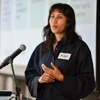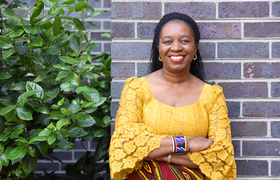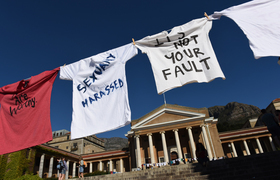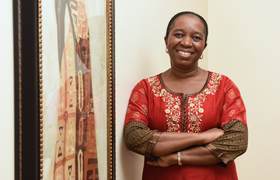How can the state support survivors of sexual violence?
15 August 2017 | Story Kate-Lyn Moore. Photo Robyn Walker.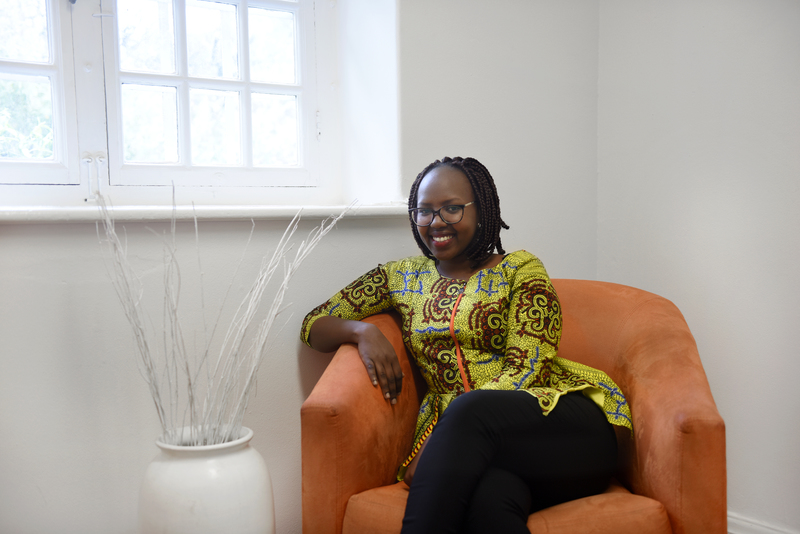
Ruth Nekura had always imagined she would be a corporate lawyer. But her life has taken a rather different turn and now, just a few months away from obtaining her PhD, she has settled somewhere between a lawyer, an activist and a social scientist.
Nekura’s PhD analyses integration as a means of fulfilling state obligations to eliminate sexual violence against women in South Africa and Kenya.
It was while completing her six-month pupillage at the Kenya Law Reform Commission that Nekura came to realise how much she enjoyed working on issues of gender-based violence.
It was 2010 and Kenya had just passed its Constitution. Hers was legislative drafting work and she was conducting background research for several laws being passed at the time.
They were primarily focused on effecting the Bill of Rights. The first research she undertook concerned women and political violence.
“I saw the challenges in the criminal justice system, for survivors of sexual violence especially, as well as the disconnect between the sectors.”
Her pupillage complete, she elected to join the Coalition On Violence Against Women (COVAW), a women’s rights NGO in Kenya, although part of her felt she was betraying her younger self and her visions of a corporate career.
She recalls the advice she received when first taking up the post: Never give the clients your personal number; find a way to offload and separate your work and your personal life.
Three months in and she had broken all of these rules.
“They had my number; I was working late hours … It was a lot of negative energy, but I loved the work we were doing.”
The job entailed the day-to-day support of cases through court.
“I saw the challenges in the criminal justice system, for survivors of sexual violence especially, as well as the disconnect between the sectors.” They were doing great work, she says. But they were doing it in silos.
At that time, COVAW was implementing a programme for integrating health, legal and psychosocial support for survivors of sexual violence to enhance their access to justice. It was this that prompted Nekura to return to her studies.
“There was a general capacity gap, I found. A lack of nuance in understanding how our practice work fits within, or reflects, broader theoretical feminist work. So I wanted to understand more about the frameworks we were using.”
Her master’s research in the UCT Faculty of Law probed the challenges of the criminal justice system when it comes to access to justice for rape survivors. Her supervisor, Professor Dee Smythe, encouraged her to build on her master’s thesis findings and pursue a PhD.
Creating local case studies
“Not much has been written on the continent about it. I’m tired of regurgitating studies from the global north about the same thing. I would like for us to also think for ourselves and generate knowledge that reflects our lived realities,” she says.
“The idea is: We acknowledge that violence against women is a complex problem that needs to be addressed in a multisectoral way. If this is the case, then there needs to be a way that everybody does [their work] in a coordinated way.
“People use different terms to describe that idea of collaboration, that idea of engaging together … I’m calling it integration. It really is just the idea that different sectors will or should work together to support survivors of sexual violence as they seek recourse through the criminal justice system.”
Integration has been explored in various forms across the globe. Nekura hoped to investigate which models would be most effective on our continent. Her research focuses on four centres in South Africa and four in Kenya.
Some contexts support the commonly held notion of the one-stop centre, where a survivor will be able to receive all of the required services under one roof. This is certainly how South Africa’s Thuthuzela Care Centre (TCC) models itself, she says. On the continent and even globally, the TCC model is lauded as a best practice for integrating.
In Kenya, what is called integration is really a system of referral networks, which could often mean that someone in the centre has a direct link to other services. This works very well, given the practical challenges of having all service providers under one roof. But such a set-up depends entirely on the strengths of each network.
For instance, if there is no collaboration, then no one knows who should speak to the survivor. Conversely, “if the survivor experiences challenges in the process, who do they tell?”
Preparing first responders
It is important that such centres identify survivors’ entry points into the justice system. In many cases, the police were assumed to be the survivor’s first port of call.
But is this really how a survivor is going to respond? In Kenya, studies show that many will go to the hospital and will not progress further, she says. Others will go to trusted community members. The TCC makes an effort to trace such people, to determine how they can also be brought into the network.
“If we align our response models to what current studies on rape construction suggest, then possibly more cases will be coming into the system in a safe way. Women will not be discouraged from coming in.”
Where’s the funding?
But how plausible is it, really, to bring clinicians, social workers, counsellors, police and lawyers into a single centre, especially when funding is scarce?
“Are we saying that integration is not possible in resource poor settings? Or are we saying that it is possible in different ways? How is it that we can integrate in our own circumstances?”
Both Kenyan and South African centres exhibited astounding creativity in overcoming broken-down systems, crippling inequality and limited resources. In Kenya, for instance, there are community health workers and paralegals who provide support placed strategically in the community.
“They work as referral networks and they work with these centres. It doesn’t cost much because they do it as part of their everyday work. The ways that they operate as points of contact for the survivors, health facilities and investigating officers was really interesting to see.”
“If I could do nothing else but show how these models work to effectively fulfil state obligations, therefore building further evidence base for these contexts, I will be glad. If it can work, then the state can invest in it and take initiative in leading it.”
 This work is licensed under a Creative Commons Attribution-NoDerivatives 4.0 International License.
This work is licensed under a Creative Commons Attribution-NoDerivatives 4.0 International License.
Please view the republishing articles page for more information.






